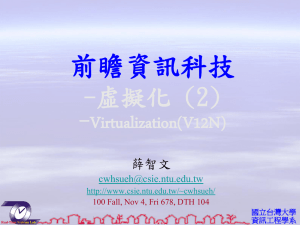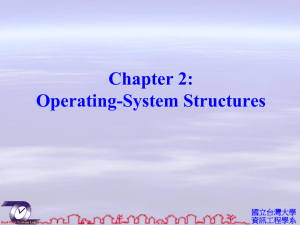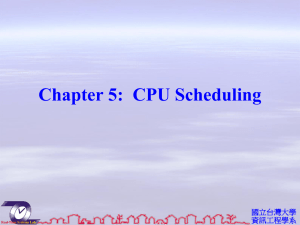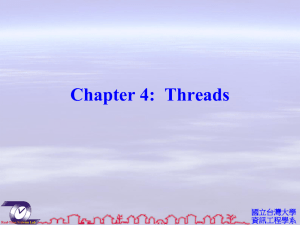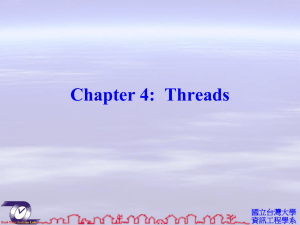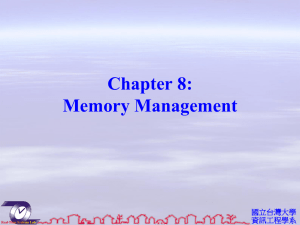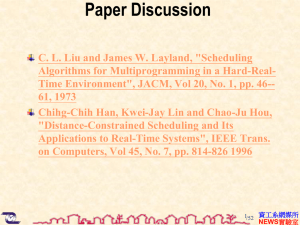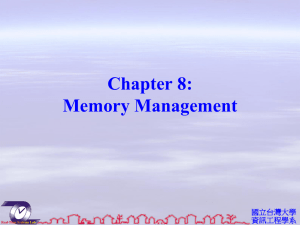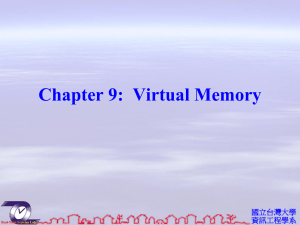資工系網媒所NEWS實驗室
advertisement
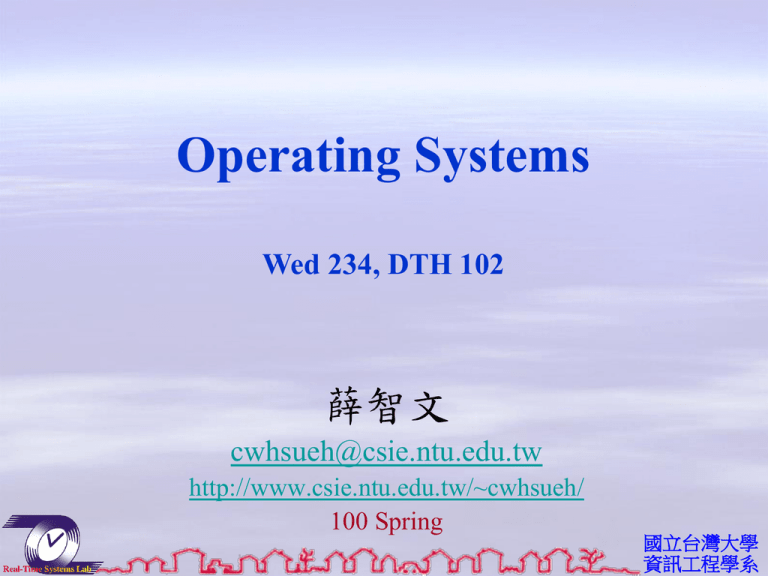
Operating Systems Wed 234, DTH 102 薛智文 cwhsueh@csie.ntu.edu.tw http://www.csie.ntu.edu.tw/~cwhsueh/ 100 Spring 國立台灣大學 資訊工程學系 1 /65 資工系網媒所 NEWS實驗室 Course Expectation Participation Ask and answer questions Do not skip the class unless … Team Work Software Engineering Turn in projects on time 2 /65 資工系網媒所 NEWS實驗室 3 /65 資工系網媒所 NEWS實驗室 Chapter 1: Introduction 國立台灣大學 資訊工程學系 Objectives To provide a grand tour of the major operating systems components To provide coverage of basic computer system organization 5 /65 資工系網媒所 NEWS實驗室 Chapter 1: Introduction What Operating Systems Do Computer-System Organization Computer-System Architecture Operating-System Structure Operating-System Operations Process Management Memory Management Storage Management Protection and Security Distributed Systems Special-Purpose Systems Computing Environments Open-Source Operating Systems 6 /65 資工系網媒所 NEWS實驗室 Chapter 1: Introduction What Operating Systems Do Computer-System Organization Computer-System Architecture Operating-System Structure Operating-System Operations Process Management Memory Management Storage Management Protection and Security Distributed Systems Special-Purpose Systems Computing Environments Open-Source Operating Systems 7 /65 資工系網媒所 NEWS實驗室 What is an Operating System? A (system) program that manages the computer hardware (and software) provides a basis for application programs and acts as an intermediary between a user of a computer and the computer hardware. 讓使用者妥善地使用軟硬體資源的系統程式 8 /65 資工系網媒所 NEWS實驗室 Operating System Goals Mainframe OSes are designed primarily to optimize utilization of hardware. PC OSes support complex games, business applications, and everything in between. OSes for handheld systems are designed to provide an environment in which a user can easily interface with the computer to execute programs. Convenient (GUI), efficient, both, or between. 9 /65 資工系網媒所 NEWS實驗室 Computer System Structure and Components Similar to a Government! 10 /65 資工系網媒所 NEWS實驗室 Operating System Definition (1/2) User View Server, Mainframe, Workstations, PC, Handhelds. System View OS is a resource allocator Manages all resources Decides between conflicting requests for efficient and fair resource use OS is a control program Controls execution of programs to prevent errors and improper use of the computer 11 /65 資工系網媒所 NEWS實驗室 Operating System Definition (2/2) No universally accepted definition “Everything a vendor ships when you order an operating system” is good approximation But varies wildly “The one program running at all times on the computer” is the kernel. Everything else is either a system program (ships with the operating system) or an application program 12 /65 資工系網媒所 NEWS實驗室 作業系統特徵遷移示意圖 1950 大型電腦 1960 1970 MULTICS 無軟體 編譯器 分時 多使用者 批次 常駐監控常式 網路 迷你電腦 1980 1990 分散式系統 多處理器 容錯 UNIX 2000 虛擬機器 虛擬化 virtualization 無軟體 編譯器 常駐監控常式 個人電腦 分時 多使用者 多處理器 網路 容錯 叢集 UNIX 虛擬機器 Cloud OS? 無軟體 編譯器 虛擬機器 交談式 多處理器 多使用者 網路 手持式電腦 2010 UNIX 虛擬化 virtualization 編譯器 無軟體 虛擬機器 交談式 虛擬化 網路 多處理器 virtualization 資工系網媒所 13 /65 NEWS實驗室 Chapter 1: Introduction What Operating Systems Do Computer-System Organization Computer-System Architecture Operating-System Structure Operating-System Operations Process Management Memory Management Storage Management Protection and Security Distributed Systems Special-Purpose Systems Computing Environments Open-Source Operating Systems 14 /65 資工系網媒所 NEWS實驗室 Computer System Organization 15 /65 資工系網媒所 NEWS實驗室 Computer-System Operation (1/2) Computer Startup bootstrap program is loaded at power-up or reboot Typically stored in ROM or EPROM, generally known as firmware Initializates all aspects of system Loads operating system kernel and starts execution One or more CPUs, device controllers connect through common bus providing access to shared memory Concurrent execution of CPUs and devices competing for memory cycles 16 /65 資工系網媒所 NEWS實驗室 Computer-System Operation (2/2) I/O devices and the CPU can execute concurrently. Each device controller is in charge of a particular device type. Each device controller has a local buffer. CPU moves data from/to main memory to/from local buffers I/O is from the device to local buffer of controller. Device controller informs CPU that it has finished its operation by causing an interrupt. 17 /65 資工系網媒所 NEWS實驗室 How a Modern Computer System Works? Cache Thread of execution CPU (*N) instruction execution cycle data movement interrupt data I/O request DMA instructions and data memory device (*M) 18 /65 資工系網媒所 NEWS實驗室 Common Functions of Interrupts Interrupt transfers control to the interrupt service routine generally, through the interrupt vector, which contains the addresses of all the service routines. Interrupt architecture must save the address of the interrupted instruction. Incoming interrupts are disabled while another interrupt is being processed to prevent a lost interrupt. A trap is a software-generated interrupt caused either by an error or a user request. An operating system is interrupt driven. 資工系網媒所 19 /65 NEWS實驗室 Interrupt Handling The operating system preserves the state of the CPU by storing registers and the program counter. Determines which type of interrupt has occurred: polling vectored interrupt system Separate segments of code determine what action should be taken for each type of interrupt 20 /65 資工系網媒所 NEWS實驗室 Interrupt Timeline 21 /65 資工系網媒所 NEWS實驗室 I/O Structure After I/O starts, control returns to user program only upon I/O completion. Wait instruction idles the CPU until the next interrupt Wait loop (contention for memory access). At most one I/O request is outstanding at a time, no simultaneous I/O processing. After I/O starts, control returns to user program without waiting for I/O completion. System call – request to the operating system to allow user to wait for I/O completion. Device-status table contains entry for each I/O device indicating its type, address, and state. OS indexes into I/O device table to determine device status and to modify table entry to include interrupt. 22 /65 資工系網媒所 NEWS實驗室 Two I/O Methods Synchronous Asynchronous 23 /65 資工系網媒所 NEWS實驗室 Device-Status Table 24 /65 資工系網媒所 NEWS實驗室 Direct Memory Access Structure Used for high-speed I/O devices able to transmit information at close to memory speeds. Device controller transfers blocks of data from buffer storage directly to main memory without CPU intervention. Only one interrupt is generated per block, rather than the one interrupt per byte. 25 /65 資工系網媒所 NEWS實驗室 Storage Structure Main memory – only large storage media that the CPU can access directly. Secondary storage – extension of main memory that provides large nonvolatile storage capacity. Magnetic disks – rigid metal or glass platters covered with magnetic recording material Disk surface is logically divided into tracks, which are subdivided into sectors. The disk controller determines the logical interaction between the device and the computer. 26 /65 資工系網媒所 NEWS實驗室 Storage Hierarchy Storage systems organized in hierarchy. Speed Cost Volatility Caching – copying information into faster storage system; main memory can be viewed as a last cache for secondary storage. 27 /65 資工系網媒所 NEWS實驗室 Storage-Device Hierarchy 28 /65 資工系網媒所 NEWS實驗室 Caching Important principle, performed at many levels in a computer (in hardware, OS, software) Information in use copied from slower to faster storage temporarily Faster storage (cache) checked first to determine if information is there If it is, information used directly from the cache (fast) If not, data copied to cache and used there Cache smaller than storage being cached Cache management important design problem Cache size and replacement policy 29 /65 資工系網媒所 NEWS實驗室 Performance of Various Levels of Storage Movement between levels of storage hierarchy can be explicit or implicit 30 /65 資工系網媒所 NEWS實驗室 Migration of Integer A from Disk to Register Multitasking environments must be careful to use most recent value, no matter where it is stored in the storage hierarchy Multiprocessor environment must provide cache coherency in hardware such that all CPUs have the most recent value in their cache Distributed environment situation even more complex Several copies of a datum can exist Various solutions covered in Chapter 17 31 /65 資工系網媒所 NEWS實驗室 Chapter 1: Introduction What Operating Systems Do Computer-System Organization Computer-System Architecture Operating-System Structure Operating-System Operations Process Management Memory Management Storage Management Protection and Security Distributed Systems Special-Purpose Systems Computing Environments Open-Source Operating Systems 32 /65 資工系網媒所 NEWS實驗室 Computer-System Architecture Single-processor systems Multiprocessor systems Increased throughput Economy of scale Increased reliability Clustered systems 33 /65 資工系網媒所 NEWS實驗室 Multiprocessor systems CPU0 registers CPU1 registers Graceful degradation cache cache Fault tolerant memory Asymmetric multiprocessing vs. symmetric multiprocessing (SMP) UMA vs. NUMA Multicore CPU core CPU core registers registers Blade server cache cache 0 CPU2 registers cache 1 memory 34 /65 資工系網媒所 NEWS實驗室 Clustered systems Linked via LAN Provide high availability Hot-standby more Provide high-performance computing Parallelization Distributed lock manager (DLM) computer interconnected computer interconnected computer Storage Area Network 35 /65 資工系網媒所 NEWS實驗室 Chapter 1: Introduction What Operating Systems Do Computer-System Organization Computer-System Architecture Operating-System Structure Operating-System Operations Process Management Memory Management Storage Management Protection and Security Distributed Systems Special-Purpose Systems Computing Environments Open-Source Operating Systems 36 /65 資工系網媒所 NEWS實驗室 Operating System Structure Multiprogramming needed for efficiency Single user cannot keep CPU and I/O devices busy at all times Multiprogramming organizes jobs (code and data) so CPU always has one to execute A subset of total jobs in system is kept in memory One job selected and run via job scheduling When it has to wait (for I/O for example), OS switches to another job Timesharing (multitasking) is logical extension in which CPU switches jobs so frequently that users can interact with each job while it is running, creating interactive computing Response time should be < 1 second Each user has at least one program executing in memory process If several jobs ready to run at the same time CPU scheduling If processes don’t fit in memory, swapping moves them in and out to run Virtual memory allows execution of processes not completely in memory 37 /65 資工系網媒所 NEWS實驗室 Memory Layout for Multiprogrammed System 38 /65 資工系網媒所 NEWS實驗室 Chapter 1: Introduction What Operating Systems Do Computer-System Organization Computer-System Architecture Operating-System Structure Operating-System Operations Process Management Memory Management Storage Management Protection and Security Distributed Systems Special-Purpose Systems Computing Environments Open-Source Operating Systems 39 /65 資工系網媒所 NEWS實驗室 Operating-System Operations Interrupt driven by hardware Software error or request creates exception or trap Division by zero, request for operating system service Other process problems include infinite loop, processes modifying each other or the OS Dual-mode operation allows OS to protect itself and other system components User mode and kernel mode Mode bit provided by hardware Provides ability to distinguish when system is running user code or kernel code Some instructions designated as privileged, only executable in kernel mode System call changes mode to kernel, return from call resets it to user 40 /65 資工系網媒所 NEWS實驗室 Transition from User to Kernel Mode Timer to prevent infinite loop / process hogging resources Set interrupt after specific period Operating system decrements counter When counter zero generates an interrupt Set up before scheduling process to regain control or terminate program that exceeds allotted time 41 /65 資工系網媒所 NEWS實驗室 Chapter 1: Introduction What Operating Systems Do Computer-System Organization Computer-System Architecture Operating-System Structure Operating-System Operations Process Management Memory Management Storage Management Protection and Security Distributed Systems Special-Purpose Systems Computing Environments Open-Source Operating Systems 42 /65 資工系網媒所 NEWS實驗室 Process Management A process is a program in execution. It is a unit of work within the system. Program is a passive entity, process is an active entity. Process needs resources to accomplish its task CPU, memory, I/O, files Initialization data Process termination requires reclaim of any reusable resources Single-threaded process has one program counter specifying location of next instruction to execute Process executes instructions sequentially, one at a time, until completion Multi-threaded process has one program counter per thread Typically system has many processes, some user, some operating system running concurrently on one or more CPUs Concurrency by multiplexing the CPUs among the processes / threads 43 /65 資工系網媒所 NEWS實驗室 Process Management Activities The operating system is responsible for the following activities in connection with process management: Creating and deleting both user and system processes Suspending and resuming processes Providing mechanisms for process synchronization Providing mechanisms for process communication Providing mechanisms for deadlock handling 44 /65 資工系網媒所 NEWS實驗室 Chapter 1: Introduction What Operating Systems Do Computer-System Organization Computer-System Architecture Operating-System Structure Operating-System Operations Process Management Memory Management Storage Management Protection and Security Distributed Systems Special-Purpose Systems Computing Environments Open-Source Operating Systems 45 /65 資工系網媒所 NEWS實驗室 Memory Management All data in memory before and after processing All instructions in memory in order to execute Memory management determines what is in memory when Optimizing CPU utilization and computer response to users Memory management activities Keeping track of which parts of memory are currently being used and by whom Deciding which processes (or parts thereof) and data to move into and out of memory Allocating and deallocating memory space as needed 46 /65 資工系網媒所 NEWS實驗室 Chapter 1: Introduction What Operating Systems Do Computer-System Organization Computer-System Architecture Operating-System Structure Operating-System Operations Process Management Memory Management Storage Management Protection and Security Distributed Systems Special-Purpose Systems Computing Environments Open-Source Operating Systems 47 /65 資工系網媒所 NEWS實驗室 Storage Management OS provides uniform, logical view of information storage Abstracts physical properties to logical storage unit - file Each medium is controlled by device (i.e., disk drive, tape drive) Varying properties include access speed, capacity, data-transfer rate, access method (sequential or random) File-System management Files usually organized into directories Access control on most systems to determine who can access what OS activities include Creating and deleting files and directories Primitives to manipulate files and dirs Mapping files onto secondary storage Backup files onto stable (non-volatile) storage media 48 /65 資工系網媒所 NEWS實驗室 Mass-Storage Management Usually disks used to store data that does not fit in main memory or data that must be kept for a “long” period of time. Proper management is of central importance Entire speed of computer operation hinges on disk subsystem and its algorithms OS activities Free-space management Storage allocation Disk scheduling Some storage need not be fast Tertiary storage includes optical storage, magnetic tape Still must be managed Varies between WORM (write-once, read-many-times) and RW 資工系網媒所 49 /65 (read-write) NEWS實驗室 I/O Subsystem One purpose of OS is to hide peculiarities of hardware devices from the user I/O subsystem responsible for Memory management of I/O including buffering (storing data temporarily while it is being transferred), caching (storing parts of data in faster storage for performance), spooling (the overlapping of output of one job with input of other jobs) General device-driver interface Drivers for specific hardware devices 50 /65 資工系網媒所 NEWS實驗室 Chapter 1: Introduction What Operating Systems Do Computer-System Organization Computer-System Architecture Operating-System Structure Operating-System Operations Process Management Memory Management Storage Management Protection and Security Distributed Systems Special-Purpose Systems Computing Environments Open-Source Operating Systems 51 /65 資工系網媒所 NEWS實驗室 Protection and Security Protection – any mechanism for controlling access of processes or users to resources defined by the OS Security – defense of the system against internal and external attacks Huge range, including denial-of-service, worms, viruses, identity theft, theft of service Systems generally first distinguish among users, to determine who can do what User identities (user IDs, security IDs) include name and associated number, one per user User ID then associated with all files, processes of that user to determine access control Group identifier (group ID) allows set of users to be defined and controls managed, then also associated with each process, file Privilege escalation allows user to change to effective ID with more rights 52 /65 資工系網媒所 NEWS實驗室 Chapter 1: Introduction What Operating Systems Do Computer-System Organization Computer-System Architecture Operating-System Structure Operating-System Operations Process Management Memory Management Storage Management Protection and Security Distributed Systems Special-Purpose Systems Computing Environments Open-Source Operating Systems 53 /65 資工系網媒所 NEWS實驗室 Distributed Systems LAN local-area network WAN wide-area network MAN metropolitan-area network SAN small-area network NOS Network operating system DOS Distributed operating system 54 /65 資工系網媒所 NEWS實驗室 Chapter 1: Introduction What Operating Systems Do Computer-System Organization Computer-System Architecture Operating-System Structure Operating-System Operations Process Management Memory Management Storage Management Protection and Security Distributed Systems Special-Purpose Systems Computing Environments Open-Source Operating Systems 55 /65 資工系網媒所 NEWS實驗室 Special-Purpose Systems Real-Time Embedded Systems Embedded systems almost always run realtime operating systems? Multimedia Systems Handheld Systems 56 /65 資工系網媒所 NEWS實驗室 Chapter 1: Introduction What Operating Systems Do Computer-System Organization Computer-System Architecture Operating-System Structure Operating-System Operations Process Management Memory Management Storage Management Protection and Security Distributed Systems Special-Purpose Systems Computing Environments Open-Source Operating Systems 57 /65 資工系網媒所 NEWS實驗室 Computing Environments (1/2) Traditional computer Blurring over time Office environment PCs connected to a network, terminals attached to mainframe or minicomputers providing batch and timesharing Now portals allowing networked and remote systems access to same resources Home networks Used to be single system, then modems Now firewalled, networked 58 /65 資工系網媒所 NEWS實驗室 Computing Environments (2/2) Client-Server Computing Dumb terminals supplanted by smart PCs Many systems now servers, responding to requests generated by clients Compute-server provides an interface to client to request services (i.e. database) File-server provides interface for clients to store and retrieve files 59 /65 資工系網媒所 NEWS實驗室 Peer-to-Peer Computing Another model of distributed system P2P does not distinguish clients and servers Instead all nodes are considered peers May each act as client, server or both Node must join P2P network Registers its service with central lookup service on network, or Broadcast request for service and respond to requests for service via discovery protocol Examples include Napster and Gnutella 60 /65 資工系網媒所 NEWS實驗室 Web-Based Computing Web has become ubiquitous PCs most prevalent devices More devices becoming networked to allow web access New category of devices to manage web traffic among similar servers: load balancers Use of operating systems like Windows 95, client-side, have evolved into Linux and Windows XP, which can be clients and servers 61 /65 資工系網媒所 NEWS實驗室 Chapter 1: Introduction What Operating Systems Do Computer-System Organization Computer-System Architecture Operating-System Structure Operating-System Operations Process Management Memory Management Storage Management Protection and Security Distributed Systems Special-Purpose Systems Computing Environments Open-Source Operating Systems 62 /65 資工系網媒所 NEWS實驗室 Open-Source Operating Systems Closed-source OS Reverse engineering Copyright, copyleft Digital Rights Management (DRM) Free Software Foundation (FSF) GNU General Public License (GPL) Linux 2.6.x, 3.x, BSD UNIX, Solaris Utility, open-source projects 63 /65 資工系網媒所 NEWS實驗室 Categories of free and nonfree software 64 /65 資工系網媒所 NEWS實驗室 End of Chapter 1 國立台灣大學 資訊工程學系
